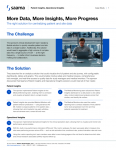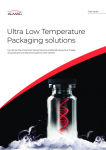How to secure the clinical supply chain in the face of a natural disaster

At Almac Clinical Services, Sharon Courtney, logistics services manager, said having an integrated approach helps the global clinical supply chain firm quickly make decisions.
“Understand the temperature restrictions, the value of the drug, the ability to replace if required or if drug can be transferred from one site to another in order to ensure there is no break in the supply chain,” Courtney told us.
Without such measures in place, companies are at risk of losing productivity and profit, though more significantly, patients’ treatment could be interrupted.
“Delivering business continuity in the event of a crisis is paramount,” Courtney added. “When disaster strikes and unexpected delays or visibility of the supply chain is lost, we must ensure the quality and the efficacy of the drug supply is protected with patient safety at the forefront of our mind.”
How? Due diligence during clinical trial planning – and expecting the unexpected.
Of the several measures to consider includes listening to the control tower, Courtney said, adding, “Having a robust control tower with 24/7 visibility ran by a team of specialists provides a highly effective solution to combat the many challenges that come transporting investigational medicinal products (IMP) globally.”
Courtney called the control tower – which makes decisions based on real-time information – the “eyes and the ears” of a company. “Therefore, it is important to listen to them when disaster strikes,” she said.
“Managing a global supply chain of sensitive material is a complicated enough task without adding a natural disaster into the mix,” said Courtney.
Outside of the company, however, it is equally as important that vendors, such as couriers and depots, also are prepared. Key to this is building solid relationships and trust. Courtney added, “Having a disaster readiness plan in place with your suppliers is paramount for when Mother Nature expectantly strikes.”
Courtney said to develop a “what if” strategy, which will help identify possible gaps to ensure every circumstance is prepared for. She also suggests pressure testing vendors to assess their response to possible scenarios.
When a hurricane hits
One possible scenario that poses a significant risk to the supply chain, especially with so many industry stakeholders located on the southeast coast, is a hurricane.
Only a few months ago, Hurricane Florence wreaked havoc on several states in the area. Ahead of landfall, US Food and Drug Administration (FDA) Commissioner Scott Gottlieb expressed concern for the life sciences industry and announced plans to assist pharmaceutical companies where required.
The supply chain organization Marken enacted contingency plans ahead of Hurricane Florence to minimize any potential impact to clients and patients throughout the storm.
“Shipments were routed to alternative airports, with Marken drivers in place to drive the shipments to their destinations upon the shipment’s landing at either RDU [Raleigh-Durham International Airport] or other airports,” explained Naresh Goundar, Marken director of operations, NORAM.
With appropriate plans in place, the company was able to deliver a shipment the day the hurricane hit – despite several airline cancellations and closures.
“The RDU airport was closed beginning Friday evening, so Marken rerouted all shipments from Friday night onwards coming in from Miami, New York, and other cities to Charlotte and then each shipment were driven from Charlotte to awaiting clients over the weekend, where client staff and Marken team members met to hand off the delivery,” Goundar told us.
For those clients who could not remain open, shipments were stored at the appropriate temperature at one of Marken’s three other locations.
As the hurricane neared, the FDA identified and tracked more than 7,000 FDA-regulated facilities, including nearly 3,000 medical product firms.
The agency deployed more than 90 Public Health Service Commissioned Corps officers to assist HHS response efforts, including pharmacists, nurses, physicians, engineers, and veterinarians


















